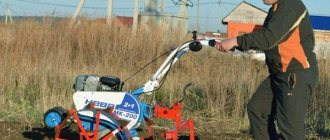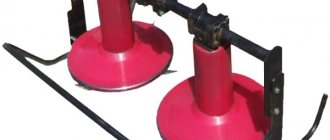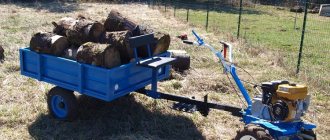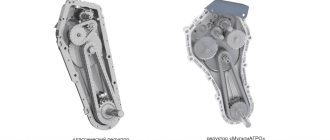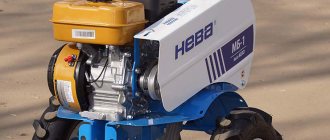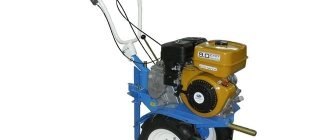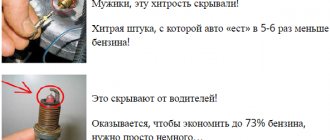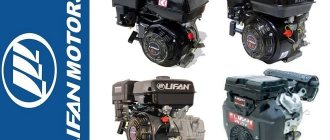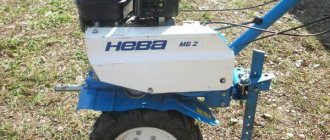- Briggs&Stratton RS750 engine
- Engine Briggs&Stratton RS950
- Engine Briggs&Stratton I/C 6.0
- Engine Briggs&Stratton I/C 10.0
- Briggs&Stratton Vanguaed engine
The MK100R-B&S (RS750) and MK200-B5.0RS motor-cultivators are equipped with Briggs&Stratton RS750 series gasoline engines with a power of 5.0 hp.
and a motor life of 1100 hours. Due to the fact that the motor cultivator is used only in the spring and autumn seasons (30 hours per year), the engine will operate stably for 20 years, provided that the operating rules and storage conditions are observed. The engine is equipped with an electronic ignition system that provides a quick response to load changes and trouble-free operation in any conditions. The outer part of the internal combustion engine working cylinder is made of aluminum, which makes the product lightweight and protects against overheating. The cylinder liner is made of cast iron, which increases the service life, strength and durability of the power unit. A reliable engine for walk-behind tractors is the Briggs&Stratton RS950 model. The engine is installed on the MB-B6.5 RS Compact walk-behind tractor, MB1-B MultiAGRO (RS950), MB2-B6.5RS. Its maximum power reaches 6.5 hp. The engine is equipped with a cast iron liner to reduce wear and provide improved oil control. Other advantages of the engine include low noise level, trouble-free starting, and fuel economy. The motor life of the engine reaches 1100 hours. If the walk-behind tractor operates in moderate mode for 100 hours a year, the power unit will last 11 years.
Briggs&Stratton I/C 6.0 petrol engine with 6.0 hp. presented on the universal walk-behind tractors MB1-B MultiAGRO FS (I/C 6.0) and MB2-B6.0FS. Its service life is estimated at 1250 hours. This means that the motor, in the absence of intense loads, will work for 12-13 years (100 hours per year). The speed of response of the internal combustion engine to changes in load is controlled by a mechanical speed controller, thereby generating more useful power during intensive operation. Double bearings and a cast iron sleeve increase the wear resistance and reliability of the motor.
The Briggs&Stratton I/C 10.0 gasoline engine is an engine for MB23-B10.0-FS walk-behind tractors. Its maximum power is 10 hp. The motor is designed for intensive and long-term use. At the same time, fuel consumption is economical without compromising power. The cast iron sleeve increases the reliability and wear resistance of the product. The motor life reaches 1250 hours, which is enough for 12-13 years when using the walk-behind tractor at 100 hours per year. The main thing is not to forget about maintenance.
Motoblocks MB2-B&S (Vanguard 6.5) PRO and MB2 MultiAGRO-B&S (Vanguard 6.5) PRO are equipped with a professional Briggs&Stratton Vanguard gasoline engine with a power of 6.5 hp. Its motor life is 2000 hours. Thus, the product will last about 20 years (with 100 hours of operation per year). According to the results of the tests, the power unit starts the first time at temperatures down to -20°C. Also, the engine operates stably when using “old” fuel. A nickel-plated carburetor allows the engine to achieve this result. In addition, the product has reduced vibration, which creates more comfortable conditions when working on a walk-behind tractor. The oil change interval is 200 hours, which corresponds to 2 years of intensive use of the product. The air filter replacement interval is 600 hours. This means that 6 years will pass before the need to replace the filter arises.
The history of the creation of the walk-behind tractor
OKA walk-behind tractors are the consumer name for walk-behind tractors made on the basis of the MB-1, produced in the eighties, a compact device with a dry weight of up to 100 kg, capable of performing various agricultural work. This device can be useful both on a household plot and on a small farmland. It can also be useful for mechanizing labor-intensive processes in certain areas of large farms. Supplied with a pair of rubber wheels and four cutters.
In a fairly short period of time, this model range has received several modifications. This is primarily due to the engine, it has become more powerful. Improvements also affected the control system. Metal rods were replaced with cables. The weak point in the gearbox has been eliminated. All these changes fully affected the MB-1D3 released in 2010.
Along with the above-mentioned model, earlier modifications are also present in the implementation, and even on the official website, sometimes the information is contradictory and contains a number of inaccuracies. In this regard, when choosing a model, you should carefully read the attached technical documentation, which is done at the highest level, in order to make the right choice.
Adjusting the valves of the Chinese engine Lifan 168F-2,170F,177F Lifan walk-behind tractor
KEY-DOP
Adjusting the engine valves
LIFAN or similar Chinese engines for walk-behind tractors
, cultivators, motor pumps, gene.
The power system consists of a fuel tank, carburetor, and fuel supply pipes. The main part is the carburetor. It does the function of a mixer. This popular rumor mixer mixes gasoline with air and delivers this mixture to the engine cylinders. Typically, a carburetor consists of smaller parts:
- float chamber;
- diffuser;
- dampers;
- spray;
- mixing chamber;
- other details.
Different models of walk-behind tractors have their own carburetors, which are regulated by different methods.
Technical characteristics of the MB-1D3 walk-behind tractor
The walk-behind tractor is similar to most devices in this class. It is made on a metal frame in such a way that it is possible to hang removable equipment on it. In this case, its own dry weight does not exceed 100 kg. Overall dimensions 1500x600x1050. Ground clearance 140 mm. Transport gauge adjustable 310, 570 mm.
Traction force 100 kgf. Capable of moving in 2nd gear at a speed of 9k m/h. In first gear - 3.6 km/h. The turning radius is 1.1 m, the width of the treated surface is no more than 1200 mm. Plowing depth up to 320 mm.
Walk-behind tractor engine
This model is equipped with an engine of our own production, KADVI DM-1M1, an 8-horsepower engine of domestic production. It is on average 8 kg heavier than its foreign-made analogues, but at the same time the torque is higher, and among the presented analogues in this line of OKA walk-behind tractors it is the strongest.
A few words about the design and operating principles.
The engine is four-stroke, single-cylinder, air-cooled, service life is 5 years. In terms of consumer properties, it belongs to inexpensive, economical engines. During production and operation, it underwent a number of modifications; previously it had a 6.5 horsepower engine, which put it at a disadvantage compared to domestic competitors.
The engine is equipped with a float carburetor. Plastic filters used in the carburetor make it easier to start the engine and provide it with acceleration and efficiency. A box-shaped muffler was designed for this engine model, which reduced engine noise by a third. Thanks to the use of new connecting rod bearings, it was possible to increase the engine service life by 3 times.
It is noted that the ignition system is designed in such a way as to make it easier to start the engine regardless of climatic conditions. The documentation supplied with the walk-behind tractor contains a number of recommendations for operating the engine. Not unimportant is the fact that the engine runs on fuel from AI76 to AI93.
Tests at factory benches have shown that with proper operation, engines of this model are capable of operating for 2000 hours without major overhauls.
Walk-behind tractor gearbox
Two-speed chain gearbox with reverse at both speeds. The advantages include ease of maintenance and reliability of gearboxes of this type, and the availability of spare parts in the range. Gearboxes of this type can be easily modified if necessary. The weak point of this type of gearbox is the needle bearings, but in models produced after 2000 this is already history.
After purchase, the device is ready for operation, the gearbox is filled with transmission oil. It is worth remembering that the first 30 hours of operation of a purchased walk-behind tractor is a break-in period. Therefore, in order to avoid failure of the device, you should not apply maximum loads.
Regarding the gearbox, it is worth saying that with proper care it works up to 3500 hours without major repairs.
Clutch
Performs the function of a torque transmission mechanism from the engine to the gearbox. As in many foreign and domestic analogues, the clutch in this model is V-belt. This is due, first of all, to the safety of operation of these units, to prevent damage to the gearbox and or engine. Also, the use of this type of clutch reduces the cost and efficiency of repairing problems that arise with the clutch. To extend the operating time of the drive belts, the device must be warmed up before starting active work.
What does replacing the engine on a Neva mb1 or mb2 motor cultivator give?
You can change the motor on Neva walk-behind tractors not only to a version of the brand with which it was made, but also to a different one, for example, more or less powerful. At the same time, you need to know which motor to choose for the Neva walk-behind tractor. In the starting configuration, models with a DM 1K engine were produced. Updated Neva walk-behind tractors can be equipped with foreign engines from the following brands:
- Robin Subaru.
- Bridgestone.
- Honda.
Replacing the engine on the Neva MB-2 walk-behind tractor with a foreign one will increase the service life, but such models are the most expensive. Therefore, if you need to replace the engine on a Neva walk-behind tractor, you need to understand that such motors are durable and wear-resistant, but their price is higher. It is important to know what alternatives there are to engines created in Japan. They take into account whether the motor will be replaced independently or at a service station. There are a large number of replacement options. The replacement option is selected based on the symbiosis of price + quality, suitability for repair, weather conditions and other factors. You can seek advice from an expert.
Attachments for walk-behind tractor
Unfortunately, on the manufacturer’s website there are a lot of inaccuracies in the description of both walk-behind tractors and attachments; the site is clearly not being developed. To clarify the relevance of any information presented on the site, you can contact the manager. When writing this article, a lot of information was taken from the websites of companies selling this equipment.
Attachments can be divided into several groups.
Active - equipment that is driven by a gear pulley:
- cultivator cutters (included in delivery);
- lugs - used to improve traction with the ground;
- rubber wheels;
- weights for wheels.
Active equipment with V-belt clutch drive:
- mower;
- snow blower;
- active brush;
- potato planter;
- root chopper;
- wood chipper;
- water pumps.
Passive equipment:
- harrow and plow;
- hillers;
- potato digger;
- transport cart;
- walk-behind shovel.
What can be included with
The unit of the St. Petersburg manufacturer can be equipped with the following types of attachments:
- lugs;
- plow;
- hiller;
- potato digger;
- mower;
- brush;
- shovel-blade;
- snow blower;
- transport trolley - single-axle and two-axle.
Neva mb 1 in work
Operation and reviews from walk-behind tractor owners
Taking into account the experience and a number of improvements, the OKA MB-1D3 is a noteworthy small-scale mechanization machine. The range of its applications was described above, but I would like to dwell separately on the direct operation of the mechanism.
The purchased walk-behind tractor must be inspected before assembly to ensure that all parts specified in the passport are present. Make sure that the warranty card is completed correctly. If everything is in order, using the detailed diagram, assemble the device.
Before the first start, you should make sure that you have transmission and engine oil. It is recommended to change the engine oil after the first 5 hours of operation. In the future, not so often, every 25-30 hours. The transmission oil is changed every 100 hours of operation. In total, before the overhaul, 80 oil changes in the engine, 1000 liters of gasoline. Transmission oil before overhauling the gearbox 35 times.
In one of the reviews about the walk-behind tractor, the owner said that he used an old walk-behind tractor of the MB-1 series, produced at the Kaluga plant in the eighties. The body kit remains with it. He took a modernized version of the MB-1D3 and noted the fact that the new model has a modified gearbox, namely (replacing needle bearings with bearings in accordance with GOST 8338-75 - bearing 306). I was pleasantly pleased with the improvements to the control system; now some operations can be performed without turning the walk-behind tractor itself, which was impossible on older models. Regarding the engine, a decrease in noise level was noted.
A review was left in an online store that sells spare parts. The buyer thanked for the sale of the gearbox and was pleased with the fact that gearboxes of a new design were now being sold.
Often, in addition to positive reviews, you can read or hear about the “disadvantages” of a V-belt drive - belts often break. As a rule, this is due to the fact that operational instructions are ignored.
One of the negative reviews was a review left regarding an adapter plate for an imported engine; a video was attached to the review in which the plate was torn in several places. The above can be supplemented by the fact that a video was published with an imported engine with strong vibration.
A video was published with a number of improvements regarding minor assembly defects, such as thin fenders, thick mudguards, and a delay when switching to reverse gear.
Often there are modifications associated with making the unit heavier for performing various operations. A video on altering the reverse linkage, or rather on moving it under the right hand, may be very useful.
One of the videos shows the use of a segment mower from a SALYUT walk-behind tractor. The mower is perfectly suitable for all modifications of the OKA walk-behind tractor.
The reviews are extremely positive, but as always point to consumables - spark plugs, belts, rare cracks in the cutters. Users mainly talk about cultivating areas of up to 20 acres (no more), making hay, and cleaning livestock buildings.
Several reviews from professionals who note some laxity of decorative components, such as wings, but the wear-resistant reliability of the cutters during extreme processing of virgin lands and lands clogged with construction waste.
There were several recommendations to take KADVI UGRA, which is a successor to the OKA series technologies. But in response, negative feedback was received regarding the expensive body kit and, oddly enough, regarding the rigid clutch.
As for the model with a cable control system specifically, it is noted that in some regions of Russia there may be a hitch when replacing cables. Plus, the gas cable requires constant lubrication.
One of the reviews gives a recipe for eliminating the “engine stalling” problem. The description of the situation is as follows. After overheating, in hot weather the brick was transported over long distances, the engine systematically overheated as a result of which the oil scraper rings became coked. As a result, the fuel filter became flooded with oil and the engine stalled after starting. According to the user, they got rid of it by pouring kerosene through the candle hole and leaving it for 12 hours.
Motoblock Neva instructions
You can download or view operating instructions for Neva walk-behind tractors of various years of manufacture on this page of the website. The user manual for repairing MB walk-behind tractors will tell you how to independently fix many of the malfunctions of your Neva equipment.
There is no doubt that walk-behind tractors are of great help when cultivating your plot or garden. They can work 10-20 hours a year and remain operational for many years, freeing you from hard, painstaking manual work.
The big problem is that instructions and manuals for our iron assistants tend to get lost over time. So we've tried to build a library of them in an accessible form in PDF format, which is ideal for printing. In fact, you will be more comfortable using printed instructions rather than simply viewing them online.
Engines DM-1D, DM-1K their repair and modernization
alldn, I have a DM-1M3 engine.
2009 release. there was a knock. Disassembled. Khan's liners have a live crankshaft. The liners came from the Zila compressor. I couldn’t find my relatives. only the Zilov ones are wider. inserted into the lid. on the side of the lock it is just the size of the bed. On the other side, I traced it with a thin awl directly along the metal of the liner, also into the edge of the bed. approximately 2mm The second liner is the same. then I carefully trimmed them with a grinder and removed the chamfers. I drilled a hole for oil in the upper connecting rod. It was like it was in my native language. Season 3 is doing well. and the rings there were VAZ ones from the classics, 76 mm from the Lada, and I installed new ones)
Greetings to all members of the forum. A year ago I bought a KADVI walk-behind tractor with a DM-1 engine. Now it's time to get busy. I started by deciding to first read about the walk-behind tractor. I’ve read up to page 20 so far and realized that it’s a bit difficult to find spare parts for DM. Maybe it will be useful to someone, I found here, it seems to me, everything that can be useful for repairing and servicing the engine. .
Today I tried to cultivate a vegetable garden, I realized that I need to get used to it. I was unpleasantly surprised when after 10-15 minutes the revs began to fluctuate, the engine began to shoot into the muffler and gradually stall! It starts up perfectly, on the first pull and stalls again.
? where to start troubleshooting?
Vasilich wrote 100%: where to start troubleshooting?
Perhaps a malfunction occurs when the ignition warms up. Change the spark plug. The carburetor may be overfilling. Is the exhaust black? Is the candle black and wet? What carb?
My thoughts are only in my head. Oh, I’ll take the swarm to the dacha, and for the weekend.
Vasilich wrote 100%: where to start troubleshooting?
Perhaps a malfunction occurs when the ignition warms up. Change the spark plug. The carburetor may be overfilling. Is the exhaust black? Is the candle black and wet? What carb?
Jesha, Thanks for the quick response! I turned the spark plug out - it was dry and slightly smoked, apparently new, GXmotor E6TS, washed it in gasoline and it looked like it came from a store. The carburetor looks like K496 (hard to read) was disassembled and a little rust was found at the bottom of the float chamber.
Vasilich 100%, Jesha, Thank you for your participation! I’m even ashamed that I didn’t check the list myself and started asking for help. I washed and blew out the carburetor, put it back in place and went to cultivate it. I'm delighted with CADVI! It's a pity that such a cool walk-behind tractor is no longer produced
. I have experience working on a homemade walk-behind tractor with a Chinese 7hp engine. and a little on SALYUT 7.5 hp. (I asked a neighbor for a ride) so personally, my opinion is that the DM-1 is more powerful, although it has less strength. I experimentally set the speed (as it suits me) and processed half of the garden in this way.
There are, of course, inconveniences in management, but I think I’ll change everything to suit myself. Inconvenient location of the locking, reverse and on levers. cutters I don’t like the throttle on a cable, I’ll convert it to traction. And that’s it, I didn’t see any more jambs! Actually, I bought it as a donor for building a mini tractor; my health does not allow me to run after a walk-behind tractor.
Vasilich 100% wrote: Vasilich 100%, Jesha, Thank you for your participation! I’m even ashamed that I didn’t check the list myself and started asking for help. I washed and blew out the carburetor, put it back in place and went to cultivate it. I'm delighted with CADVI! It's a pity that such a cool walk-behind tractor is no longer produced
. I have experience working on a homemade walk-behind tractor with a Chinese 7hp engine. and a little on SALYUT 7.5 hp. (I asked a neighbor for a ride) so personally, my opinion is that the DM-1 is more powerful, although it has less strength. I experimentally set the speed (as it suits me) and processed half of the garden in this way. There are, of course, inconveniences in management, but I think I’ll change everything to suit myself. Inconvenient location of the locking, reverse and on levers. cutters I don’t like the throttle on a cable, I’ll convert it to traction. And that’s it, I didn’t see any more jambs! Actually, I bought it as a donor for building a mini tractor; my health does not allow me to run after a walk-behind tractor. Well, time will tell what to do next. And regarding checking the fuel level in the float chamber, maybe it’s not worth getting into the established mechanism? It starts up perfectly, from the first pull, no smoke. Now I’ll go and unscrew the spark plug just for fun.
Vasilich 100%, First check the sump and tank for dirt and rust. It probably got into the carburetor from there, and if you don’t remove it, it will get in again. And you can make a front adapter for the MB, it’s easier than a mini tractor, and the original functions are preserved.
Vasilich 100% wrote: Greetings to all forum members. I bought a KADVI walk-behind tractor with a DM-1 engine a year ago. Now it's time to get busy. I started by deciding to first read about the walk-behind tractor. I’ve read up to page 20 so far and realized that it’s a bit difficult to find spare parts for DM. Maybe it will be useful to someone, I found here, it seems to me, everything that can be useful for repairing and servicing the engine. .
Vasilich 100%, according to spare parts for MB - cylinder block - 5,500 rubles, cheaper to buy a Chinese engine. By the way, there are 2 pieces. DM-1, if anyone needs it, I’ll give it away for cheap, or I’ll exchange it for something motor-block.
Vasilich 100% wrote: Vasilich 100%, Jesha, Thank you for your participation! I’m even ashamed that I didn’t check the list myself and started asking for help. I washed and blew out the carburetor, put it back in place and went to cultivate it. I'm delighted with CADVI! It's a pity that such a cool walk-behind tractor is no longer produced
. I have experience working on a homemade walk-behind tractor with a Chinese 7hp engine. and a little on SALYUT 7.5 hp. (I asked a neighbor for a ride) so personally, my opinion is that the DM-1 is more powerful, although it has less strength. I experimentally set the speed (as it suits me) and processed half of the garden in this way. There are, of course, inconveniences in management, but I think I’ll change everything to suit myself. Inconvenient location of the locking, reverse and on levers. cutters I don’t like the throttle on a cable, I’ll convert it to traction. And that’s it, I didn’t see any more jambs! Actually, I bought it as a donor for building a mini tractor; my health does not allow me to run after a walk-behind tractor. Well, time will tell what to do next. And regarding checking the fuel level in the float chamber, maybe it’s not worth getting into the established mechanism? It starts up perfectly, from the first pull, no smoke. Now I’ll go and unscrew the spark plug just for fun.
Vasilich 100%, First check the sump and tank for dirt and rust. It probably got into the carburetor from there, and if you don’t remove it, it will get in again. And you can make a front adapter for the MB, it’s easier than a mini tractor, and the original functions are preserved.
Oltyur, Thank you for the advice! I just remembered my son-in-law once washed the tank on a scooter, cut about 15-20 old bearings, poured balls into the tank, splashed a little water, screwed the tank into a concrete mixer with wire and turned it on for about 20 minutes. After such manipulations, the inside of the tank shone like new.
I really don’t know what condition the tank is in now. Perhaps the gas tanks are treated with something from the factory. Although China, I think, doesn’t bother! The balls are still lying around somewhere, tomorrow I’ll carry out the necessary manipulations. And as for the price of spare parts, I don’t think that anyone will buy a cylinder block, at most (I understood from reading the forum) a connecting rod needs to be replaced, maybe a crankshaft, a CONNECTING ROD OIL SPRAYER for 70 rubles, which is mainly responsible for problems, rings, etc. I think it's much cheaper than the new Chinese one. Although of course the Chinese have many advantages.
Criterias of choice
When choosing an engine for a walk-behind tractor, you should pay attention to several characteristics. First you need to decide on the type of engine
Walk-behind tractors use both gasoline and diesel units. The table shows their advantages:
| Gasoline | Diesel |
|
|
The second criterion when choosing a Chinese engine is power:
- On a light walk-behind tractor it will be enough to install a device with a power of up to 4 liters. With.;
- medium ones require an engine with 4–7 liters. With.;
- for heavy walk-behind tractors, a 7 hp unit is required. With. and more.
You also need to pay attention to the following characteristics:
- Crankshaft output. The most common ones are with a key, and those often used are with a splined exit. Less commonly used is a conical shaft overhang.
- Oil level sensor. This will prevent damage to the device.
- The presence of an electric starter will make it much easier to start the engine when it comes to gasoline units. Diesel engines are more suitable for manual starting.
- Air filter. It comes with an oil bath and double cleaning.
- Motor resource. Models where this criterion reaches 3000 operating hours or more are recommended.
Related video: How to choose a gasoline engine: 5 tips
Publications on the topic
Characteristics of the most powerful walk-behind tractors
Opportunities and advantages of operating walk-behind tractors with a Honda engine
Rules for selecting and installing an engine for the Mole walk-behind tractor

